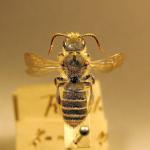This bee is only known as British from two female specimens captured at Guestling, near Hastings, East Sussex, in 1877 and 1878.
Abroad, this is a predominantly Western Palaearctic species known in central Europe, from southern Sweden south to Italy, west to France and east to Siberia (Russian Federation). It is known from Turkey and is particularly frequent in the Czech Republic and Slovakia.
This bee is regarded as Extinct (Appendix) in both Shirt (1987) and Falk (1991).
The British habitat preferences are unclear although the locality at Guestling at the time was partly wooded.
The 1878 specimen was collected in early August. In Poland it is described as a univoltine summer species (Pesenko et al., 2000).
This is a mining bee nesting in small aggregations. There is a tumulus at the entrance to the nest. The main burrow is dug to a depth of 7-10 cm at an angle of about 60 degrees to the surface, then bends for 3-5 cm and then goes down vertically for another 5-8 cm. Some 8-10 spherical cells are constructed off this burrow at the end of short lateral burrows. After the female has provisioned a cell she lays an egg and then seals the cell with a plug of earth 2-3 mm thick. The larva is said to feed for about three weeks and then pupate, spinning a two-layered cocoon which tightly adjoins the cell walls (Pesenko et al., 2000).
Abroad, the females are usually recorded on Lamiaceae but the males can be found on a range of flowers including Lamiaceae, Asteraceae, Rosaceae, Campanulaceae and others.
The bee Biastes emarginatus (Schenck) (Apidae: Nomadinae) is a cleptoparasite of this species in much of Europe.
2019


